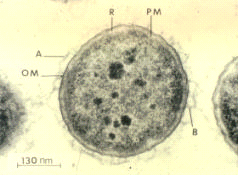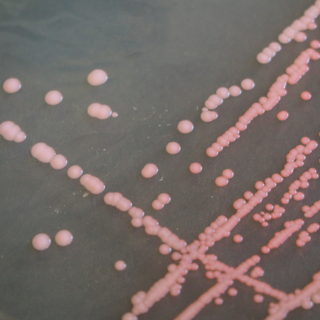
Klebsiella is a genus of Gram-negative, oxidase-negative, rod-shaped bacteria with a prominent polysaccharide-based capsule.

Proteus mirabilis is a Gram-negative, facultatively anaerobic, rod-shaped bacterium. It shows swarming motility and urease activity. P. mirabilis causes 90% of all Proteus infections in humans. It is widely distributed in soil and water. Proteus mirabilis can migrate across the surface of solid media or devices using a type of cooperative group motility called swarming. Proteus mirabilis is most frequently associated with infections of the urinary tract, especially in complicated or catheter-associated urinary tract infections.

Escherichia is a genus of Gram-negative, non-spore-forming, facultatively anaerobic, rod-shaped bacteria from the family Enterobacteriaceae. In those species which are inhabitants of the gastrointestinal tracts of warm-blooded animals, Escherichia species provide a portion of the microbially derived vitamin K for their host. A number of the species of Escherichia are pathogenic. The genus is named after Theodor Escherich, the discoverer of Escherichia coli. Escherichia are facultative aerobes, with both aerobic and anaerobic growth, and an optimum temperature of 37 °C. Escherichia are usually motile by flagella, produce gas from fermentable carbohydrates, and do not decarboxylate lysine or hydrolyze arginine. Species include E. albertii, E. fergusonii, E. hermannii, E. marmotae and most notably, the model organism and clinically relevant E. coli. Shimwellia blattae was formerly classified in this genus.

Enterobacter is a genus of common Gram-negative, facultatively anaerobic, rod-shaped, non-spore-forming bacteria of the family Enterobacteriaceae. It is the type genus of the order Enterobacterales. Several strains of these bacteria are pathogenic and cause opportunistic infections in immunocompromised hosts and in those who are on mechanical ventilation. The urinary and respiratory tracts are the most common sites of infection. The genus Enterobacter is a member of the coliform group of bacteria. It does not belong to the fecal coliforms group of bacteria, unlike Escherichia coli, because it is incapable of growth at 44.5 °C in the presence of bile salts. Some of them show quorum sensing properties.

Providencia is genus of Gram-negative, motile bacteria of the family Morganellaceae. It was named after Providence, Rhode Island, where C. A. Stuart and colleagues studied these bacteria at Brown University.
Streptococcus bovis is a species of Gram-positive bacteria that in humans is associated with urinary tract infections, endocarditis, sepsis, and colorectal cancer. S. gallolyticus is commonly found in the alimentary tract of cattle, sheep, and other ruminants, and may cause ruminal acidosis or feedlot bloat. It is also associated with spontaneous bacterial peritonitis, a frequent complication occurring in patients affected by cirrhosis. Equivalence with Streptococcus equinus has been contested.
The indole test is a biochemical test performed on bacterial species to determine the ability of the organism to convert tryptophan into indole. This division is performed by a chain of a number of different intracellular enzymes, a system generally referred to as "tryptophanase."
Klebsiella aerogenes, previously known as Enterobacter aerogenes, is a Gram-negative, oxidase negative, catalase positive, citrate positive, indole negative, rod-shaped bacterium. The bacterium is approximately 1-3 microns in length, and is capable of motility via peritrichous flagella.

Aeromonas salmonicida is a pathogenic bacterium that severely impacts salmonid populations and other species. It was first discovered in a Bavarian brown trout hatchery by Emmerich and Weibel in 1894. Aeromonas salmonicida's ability to infect a variety of hosts, multiply, and adapt, make it a prime virulent bacterium. A. salmonicida is an etiological agent for furunculosis, a disease that causes sepsis, haemorrhages, muscle lesions, inflammation of the lower intestine, spleen enlargement, and death in freshwater fish populations. It is found worldwide with the exception of South America. The major route of contamination is poor water quality; however, it can also be associated stress factors such as overcrowding, high temperatures, and trauma. Spawning and smolting fish are prime victims of furunculosis due to their immunocompromised state of being.
Voges–Proskauer or VP is a test used to detect acetoin in a bacterial broth culture. The test is performed by adding alpha-naphthol and potassium hydroxide to the Voges-Proskauer broth which has been inoculated with bacteria. A cherry red color indicates a positive result, while a yellow-brown color indicates a negative result.

Aerococcus is a genus in the phylum Firmicutes (Bacteria). The genus was first identified in 1953 from samples of air and dust as a catalase-negative, gram-positive coccus that grew in small clusters. They were subsequently found in hospital environments and meat-curing brines. It has been difficult to identify as it resembles alpha-hemolytic Streptococcus on blood agar plates and is difficult to identify by biochemical means. Sequencing of 16S rRNA has become the gold standard for identification, but other techniques such as MALDI-TOF have also been useful for identifying both the genus and species.
Butyricicoccus is a bacterial genus from the family of Clostridiaceae.
Tenacibaculum agarivorans is a Gram-negative, aerobic, rod-shaped agar-digesting bacterium from the genus of Tenacibaculum which has been isolated from the alga from the coast of Weihai in China.
Acanthopleuribacter pedis is a Gram-negative, rod-shaped bacterium found in marine environments.
Butyricimonas is a Gram-negative and anaerobic genus of bacteria from the family of Odoribacteraceae. This bacterium is present in the gastrointestinal tract of various mammals such as rats and humans.

The Morganellaceae are a family of Gram-negative bacteria that include some important human pathogens formerly classified as Enterobacteriaceae. This family is a member of the order Enterobacterales in the class Gammaproteobacteria of the phylum Proteobacteria. Genera in this family include the type genus Morganella, along with Arsenophonus, Cosenzaea, Moellerella, Photorhabdus, Proteus, Providencia and Xenorhabdus.
Tumebacillus luteolus is a species of Gram positive, aerobic, bacterium. The cells are rod-shaped, non-motile, and form spores. It was first isolated from soil in Ukraine. The species was first described in 2015, and the name is derived from Latin luteolus (yellowish), referring to the colony color on R2A agar.
Tumebacillus soli is a species of Gram positive, aerobic, bacterium. The cells are rod-shaped, motile, and form spores. It was first isolated from soil in Danghangpo, South Korea. The species was first described in 2015, and the name refers to its initial isolation from soil.

Arthrobacter bussei is a pink-coloured, aerobic, coccus-shaped, Gram-stain-positive, oxidase-positive and catalase-positive bacterium isolated from cheese made of cow´s milk. A. bussei is non-motile and does not form spores. Rod–coccus life cycle is not observed. Cells are 1.1–1.5 µm in diameter. On trypticase soy agar it forms pink-coloured, raised and round colonies, which are 1.0 mm in diameter after 5 days at 30 °C The genome of the strain A. bussei KR32T has been fully sequenced.
Aequorivita todarodis is a Gram-negative, aerobic, rod-shaped and non-motile bacterium from the genus of Aequorivita which has been isolated from the intestinal tract of squid.







